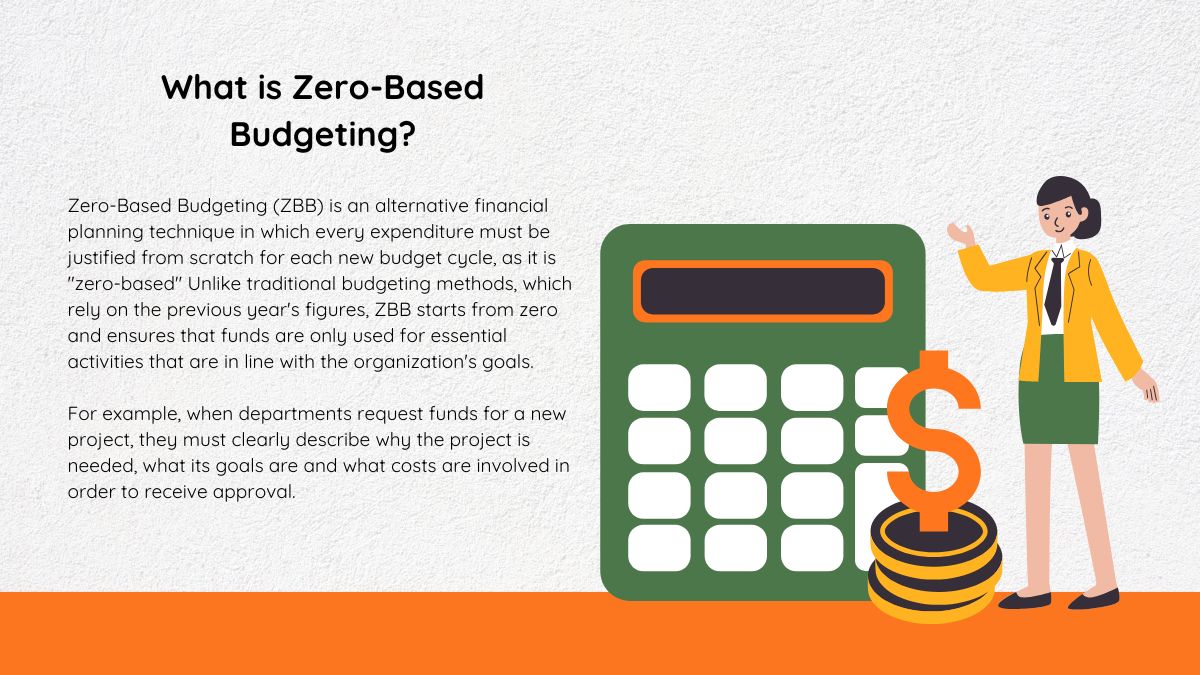Explore the Zero-Based Budgeting method: its steps, its process, its benefits, and its limitations. Learn why this unique approach to financial planning differs from traditional budgeting approaches and the benefits it offers for improving overall planning.
In this article, you’ll learn what zero-based budgeting is, what its features are, and how you can implement it step by step. We’ll also look at its benefits and limitations, how it differs from traditional budgeting, and its importance in modern financial planning.
Whether you want to improve your cost efficiency or align your spending with strategic goals, this comprehensive guide will help you understand the value and challenges of implementing ZBB.
What is Zero-Based Budgeting?

Zero-Based Budgeting (ZBB) is an alternative financial planning technique in which every expenditure must be justified from scratch for each new budget cycle, as it is “zero-based” Unlike traditional budgeting methods, which rely on the previous year’s figures, ZBB starts from zero and ensures that funds are only used for essential activities that are in line with the organization’s goals.
For example, when departments request funds for a new project, they must clearly describe why the project is needed, what its goals are and what costs are involved in order to receive approval.
Who Introduced Zero-Based Budgeting in India?
Zero-Based Budgeting (ZBB) was introduced in India in the 1980s by the then Finance Minister Rajiv Gandhi to increase efficiency and accountability in government spending by requiring every expenditure to be justified from the ground up.
ZBB used this approach to maximize limited resources, reduce unnecessary spending, and align budgets with development priorities. By maintaining transparency and prioritizing current needs, ZBB enabled India’s economic reforms in times of budgetary constraints.
Features of Zero-Based Budgeting
Zero-based budgeting (ZBB) is a disciplined financial tool used by organizations to manage resources effectively. Its features include:
- Zero-Based Starting Point:
Budgets are built from the ground up, starting from zero, instead of relying on previous figures. - Activity-Driven Analysis:
Every expense is scrutinized for its purpose and contribution to organizational goals. - Cost-Benefit Focus:
Each expense is evaluated for its return on investment, ensuring resources are used effectively. - Strategic Resource Allocation:
Funds are prioritized for activities that generate the highest value. - Adaptability:
ZBB is tailored to meet the unique needs of individual organizations or departments. - Transparent Decision-Making:
Requiring justification for expenses promotes greater transparency and accountability. - Elimination of Redundancy:
The approach identifies and eliminates unnecessary or outdated expenditures.
Process of Zero-Based Budgeting
The process of zero-based budgeting involves several structured steps, enabling organizations to allocate resources effectively:
- Establish Goals and Priorities:
Clearly define organizational objectives to ensure budgeting efforts align with strategic goals.
- Create Decision Units:
Divide the organization into smaller units (e.g., departments or projects), each responsible for preparing its own budget.
- Develop Expense Justifications:
Each unit must justify its expenses by detailing the purpose, cost, and expected outcomes of every activity.
- Rank Activities by Importance:
Evaluate activities based on their contribution to organizational goals and prioritize them accordingly.
- Allocate Resources:
Distribute funds to prioritized activities, ensuring critical areas receive adequate support.
- Monitor and Review:
Continuously track expenditures and review the budget to identify potential areas for improvement.
By these structured steps, zero-based budgeting empowers organizations to optimize resource allocation, enhance financial accountability, and drive strategic success.
Steps of Zero-Based Budgeting
Implement zero-based budgeting efficiently by following these detailed steps:
Define Objectives:
- Identify short-term and long-term goals.
- Align budgeting efforts with these objectives.
Break Down Operations:
- Divide the organization into smaller units, like departments.
- Assign responsibility for budgeting to unit heads.
Analyze Activities:
- Evaluate all activities based on necessity and alignment with objectives.
- Justify each activity from scratch without relying on past budgets.
Prioritize Expenses:
- Rank activities based on importance, expected outcomes, and cost-effectiveness.
Allocate Budget:
- Distribute resources based on priority rankings.
- Ensure critical activities receive adequate funding.
Regular Monitoring:
- Track budget performance throughout the cycle.
- Address deviations and make adjustments as necessary.
Review and Improve:
- Conduct post-budget reviews to identify areas for optimization.
Read More:
- What is Zero Debt Insurance? Protecting Your Legacy with Insurance Coverage
- What Does Financial Freedom Mean? Defining Your Path to True Wealth
How Zero-Based Budgeting Differs from Traditional Budgeting
Understanding the differences between zero-based budgeting and traditional budgeting is crucial for determining the best approach.
| Aspect | Zero-Based Budgeting | Traditional Budgeting |
| Starting Point | Starts from zero, every expense justified. | Builds on the previous year’s budget. |
| Evaluation of Activities | Detailed cost-benefit analysis for all activities. | Focuses on incremental adjustments. |
| Flexibility | Highly adaptable to changing needs. | Rigid, often slow to adjust. |
| Resource Allocation | Prioritized based on strategic importance. | Largely based on historical spending patterns. |
Zero-Based Budgeting Advantages and Disadvantages
Here’s a summary of the pros and cons of zero-based budgeting:
Advantages:
- Optimizes resource allocation.
- Enhances accountability and transparency.
- Promotes cost control and eliminates redundancy.
- Adapts to changing organizational priorities.
Disadvantages:
- Time-intensive and complex.
- May face resistance from employees.
- Requires significant resources and expertise.
Why Zero-Based Budgeting Matters
Zero-based budgeting is a powerful financial tool that encourages organizations to evaluate and justify every expense. By starting from scratch, ZBB helps eliminate inefficiencies, align resources with strategic goals and improve accountability.
For businesses, government agencies and non-profit organizations, implementing ZBB can lead to better financial discipline and better decision-making. However, its successful implementation requires commitment, expertise and continuous effort.
Conclusion
Zero-based budgeting is a comprehensive and effective method for financial planning. While it may be resource-intensive, the potential benefits—such as cost savings, improved efficiency, and strategic resource allocation—make it worth considering for organizations of all sizes.




